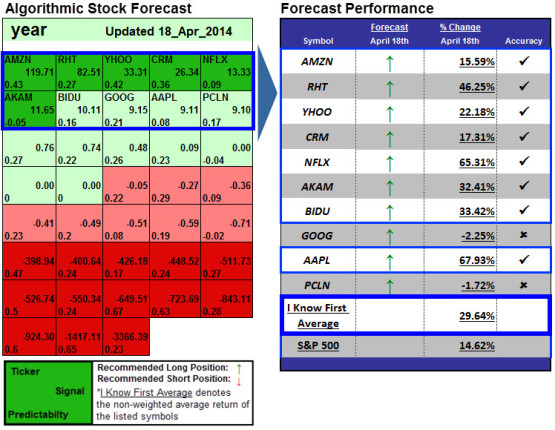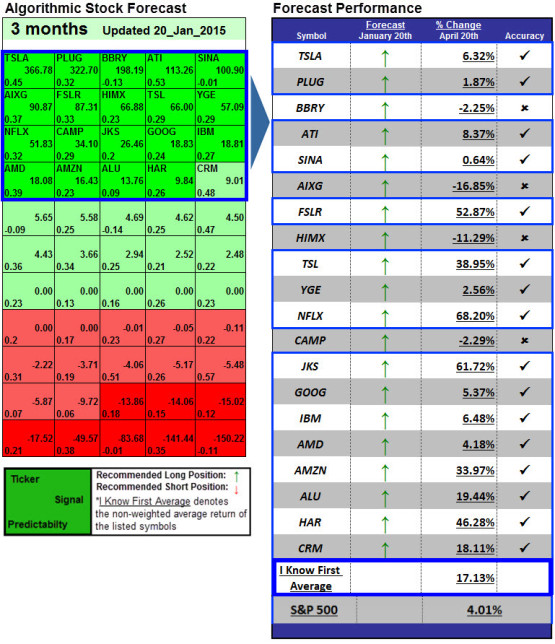Amazon Needs Revenue Growth, Not Profits: An Algorithmic Analysis
 Amazon (AMZN) beat market analysts’ expectations for both revenue and earnings per share during its most recent earnings report on Thursday. The company’s stock price soared to record highs as a result, settling 14% higher. I Know First wrote a bullish article on Amazon on February 9, which can be read here, predicting the stock price would climb. Since that time, it has increased 18.92% as the article argued it would. Some market watchers continue to be bearish against the stock, even after the positive results, citing the company’s ‘inability’ to make a profit. While it is true that the company did have a negative operating income during the last quarter and that its P/E ratio is extremely high, the company is still a sound investment for the coming quarter and beyond, as Amazon’s cloud service proved to be far more valuable than previously thought. Besides this positive news, it continues to spend on finding new areas for revenue growth in the future, and algorithmic analysis for the company is bullish as well.
Amazon (AMZN) beat market analysts’ expectations for both revenue and earnings per share during its most recent earnings report on Thursday. The company’s stock price soared to record highs as a result, settling 14% higher. I Know First wrote a bullish article on Amazon on February 9, which can be read here, predicting the stock price would climb. Since that time, it has increased 18.92% as the article argued it would. Some market watchers continue to be bearish against the stock, even after the positive results, citing the company’s ‘inability’ to make a profit. While it is true that the company did have a negative operating income during the last quarter and that its P/E ratio is extremely high, the company is still a sound investment for the coming quarter and beyond, as Amazon’s cloud service proved to be far more valuable than previously thought. Besides this positive news, it continues to spend on finding new areas for revenue growth in the future, and algorithmic analysis for the company is bullish as well.
Amazon Web Services Releases Results
During the earnings report, Amazon released the earnings results from its cloud service, AWS, for the first time. The cloud computing business had sales of $1.57 billion during the last quarter, an increase of 49%. This kind of revenue growth is impressive, and should only continue into 2016 as more and more companies move to the cloud. Impressively, this business segment had operating profits of $265 million, a 17% operating margin, which shocked market analysts. Most had been expecting the cloud service to be operating at a loss, or maybe break even as a best-case scenario.
The sales and profit figures released for AWS for the first time reveal the size and success of this business. Yearly, it is making about $1 billion on $6 billion in revenue. This is truly incredible considering the fact that the business was not started until 2006, and that the tech world did not realize its potential until roughly 2010. This was when people noticed that most startups were using the service to host their sites. But nobody until this point realized how big or successful the service was, as sales figures were not released.
Now that they have been, sales are expected to continue to increase, although the operating margin involved will likely fall. Competitors in the field, such as Google (GOOG), Microsoft (MSFT), and IBM (IBM), are engaged in a price war of sorts, causing the price point for the service to fall. While profit margins are likely to fall, CEO Jeff Bezos emphasized in his annual letter to shareholders how the company has worked hard to make the service as easy as possible to use. While it is still complex, the functionality will make it difficult for customers to leave, as they will not want to learn a new set of tools and APIs when they are already able to use AWS easily and efficiently.
Amazon Not Focused On Net Income
Amazon has continued to not put an emphasis on profits throughout its two decades as a company. While its revenue growth has been steadily impressive for the past 10 years, profit has been at or close to $0 for all of that time, as can be seen below. Instead of focusing on net income, the company uses its free cash flow to invest in new businesses, such as AWS. This investment will allow the company to continue to grow revenue in the future, even after its retail business in the US and internationally stops growing.

One example of a business that Amazon is investing in is its same day delivery service through Amazon Prime. Over the past several weeks, the company has expanded this service to Dallas, Atlanta, and Austin. Doing so requires lots of spending, as warehouses need to be built to house all of the merchandise that is needed and distribution networks have to be set up to ensure that the products are delivered as promised. This kind of service has been thought of ever since the dot com bubble, but the task has been monumental. If Amazon can conquer it, it will lead more customers to sign up for Amazon Prime, which leads to those consumers using Amazon’s web services more.
A couple of other businesses that the company is currently investing in are Amazon Destinations, a marketplace for booking local hotel getaways, and Amazon Home Services, which lets shoppers book plumbers, home cleaners, or TV installers through Amazon. Investments like these are not guaranteed to be successful, as critics like to point to the Amazon Fire, which has largely been a failure to this point. But the willingness to spend cash to find drivers of future revenue growth is key for a company of this size. Still looking to set up a drone delivery service, the innovative ideas from Amazon will lead to more business developments to drive revenue growth in the future, meaning that its stock price should continue to increase.
Algorithmic Analysis
Our algorithm incorporates a 15-year database, and utilizes it to predict the flow of money across 2000 markets. The algorithm has more data to forecast within the long term and, naturally, outputs a more accurate predication in that time frame. Having said that, intraday traders, along with short-term players, will also benefit by taking the algorithmic perspective into consideration.
The self-learning algorithm uses artificial inelegance, predictive models based on artificial neural networks, and genetic algorithms to predict money movements within various markets.
The algorithm produces a forecast with a signal and a predictability indicator. The signal is the number in the middle of the box. The predictability is the number at the bottom of the box. At the top, a specific asset is identified. This format is consistent across all predictions. The middle number is indicative of strength and direction, not a price target. The bottom number, the predictability, signifies a confidence level.

Above is a 1-year prediction from April 18t, 2014. Amazon had a signal strength of 119.71 and a predictability indicator of 0.43. In accordance with the algorithm’s prediction, the stock price increased 15.59% in the predicted time horizon. Another example of I Know First correctly predicting Amazon’s stock price is show below.

Having demonstrated examples of when I Know First’s algorithm was able to correctly predict the behavior of Amazons’s stock price in the past, looking at the current forecast can add meaning to the fundamental analysis above.

The last figure includes the one-month and three-month forecasts for Amazon from April 26, 2015. In both forecasts, the company has a very strong signal, indicating the algorithm believes the stock is vastly undervalued for the respective time horizons. This is in agreement with the algorithmic analysis. The stock price should continue to climb, as more revenue from AWS will continue to grow. Market analysts, including JP Morgan and Raymond James, have been raising their price estimates for Amazon since its earnings report. As more analysts raise their estimates, the stock price will continue to climb, making this a strong stock to buy right now.











